Pop's Spicy Dill Pickles recipe is legendary; zesty, garlicky, crunchy, and packed with all that old-fashion dill pickle flavor you can't find in a store.
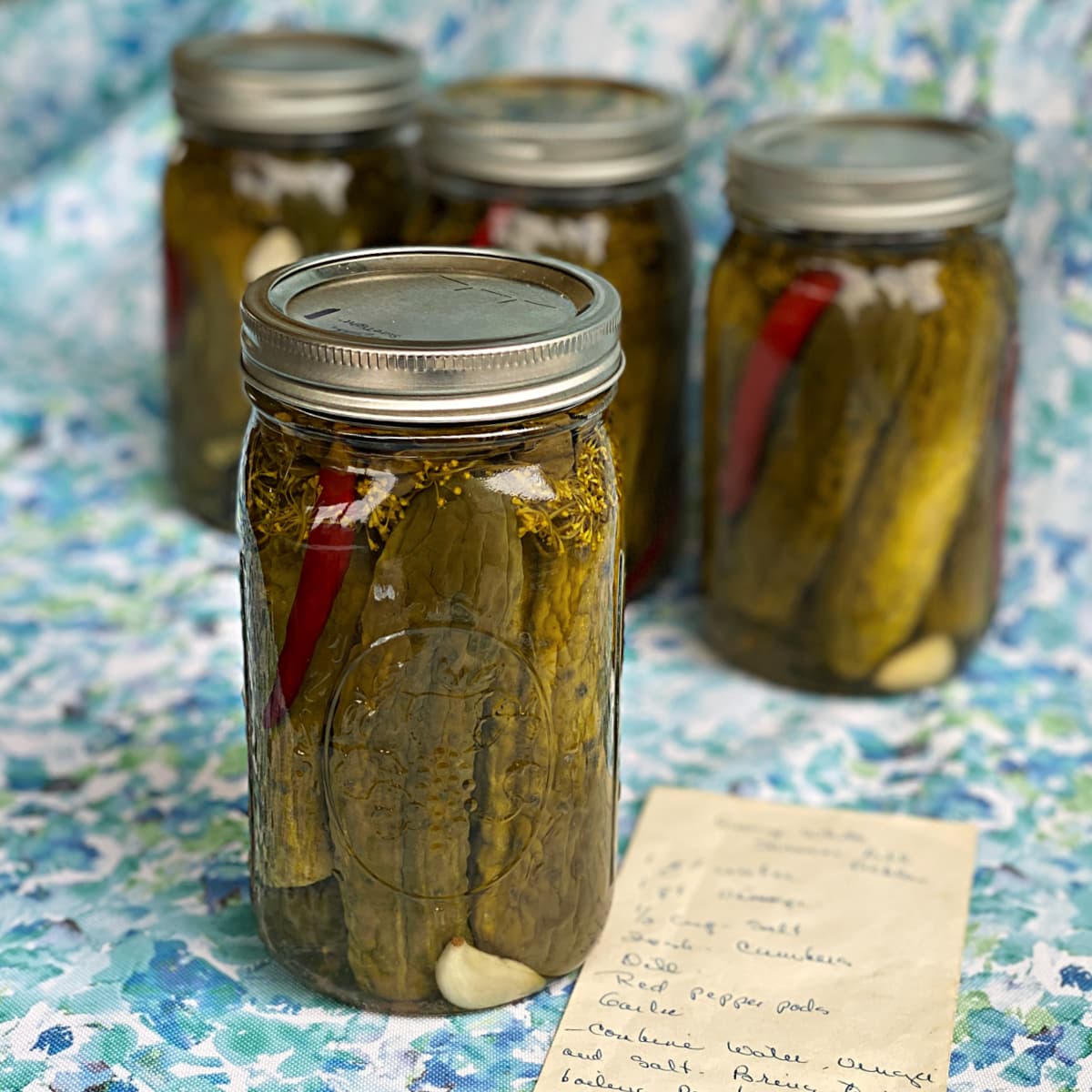
Jump to:
What's the Story Behind this Spicy Pickle Recipe?
George Smith Service Center Dills
My family has been using this heirloom spicy dill pickle recipe for more than 70 years. A variation on "George Smith Service Dill Pickles," our version comes from my mother, who copied the recipe onto an envelope sometime in the 1960's.
I remember Pop occasionally referring to our dill pickles as Service Dills, but as a child thought that was because they were originally made for people in the armed services. (My family was full of vets: it's a natural assumption for a kid to make.)
As it turns out, I wasn't too far off the mark; but figuring that out took some work. When I first tried find a little background on this recipe, the only reference was a similar garlic dill pickle recipe from a member of the Daughters of Norway. I then reached out to my friend Gena, a genealogy expert who shares my love of heritage recipes and ephemera. Unfortunately, she was unable to find any reference to it among in her resources either.
I finally located a few references to the George White Serve Center for World War II service men and women, which I learned was founded in Portland, Oregon in 1942. This aligns directly with my family history: Pop moved his entire family to Portland from the midwest in 1943 to work in the shipyards during the war.
The origin of this pickle recipe, on the other hand, remains something of a mystery; nevertheless, they are delicious, and well worth both the effort and the wait!
Pickled Memories
Pickling season is one of my earliest memories. Or rather, the smells of pickling season. I remember when I was about three or four, sitting on the top basement step and listening to the sharp clink of mason jars, and breathing in the briny scent of warm cucumbers and garlic that wafted up from Pop's basement canning kitchen.
My job was to run up and down the stairs whenever anyone needed anything. Sitting at the top of the stairs was a good place to watch and stay out of trouble.
My mother, aunt, and grandpa made a line-assembly canning team worthy of Henry Ford. First there was Auntie (always a stickler for order) carefully packing fresh cucumbers into quart jars, puzzling more into each one than seemed humanly possible. Then Mom took the jar from her and searched for nooks and crannies between the tightly packed cucumbers, where she would pop in peppers, garlic, and dill before covering it all with a grape leaf blanket and lining it up on a clean tea towel.
When a batch was ready to be put into the canner, Pop would fill in the leftover spaces in each jar with hot, salty brine and place them in an enormous blue-speckled water-bath canner. They ran two canners for what seemed like all day: the work never ended until all the cucumbers were jarred. (In reality, you can process one batch, start to finish, in about an hour.) At the end of the day though, we had enough pickles for everyone to last at least a year, plus some to give away as gifts.
After that, all I remember is a lot of waiting, because dill pickles must cure for at least six weeks after being made. If we ran out of pickles from the previous year before the new ones were ready, life seemed interminable. (I mean, how was I gonna make a peanut butter & dill pickle sandwich without them‽)
What Goes into this Dill Pickle Recipe
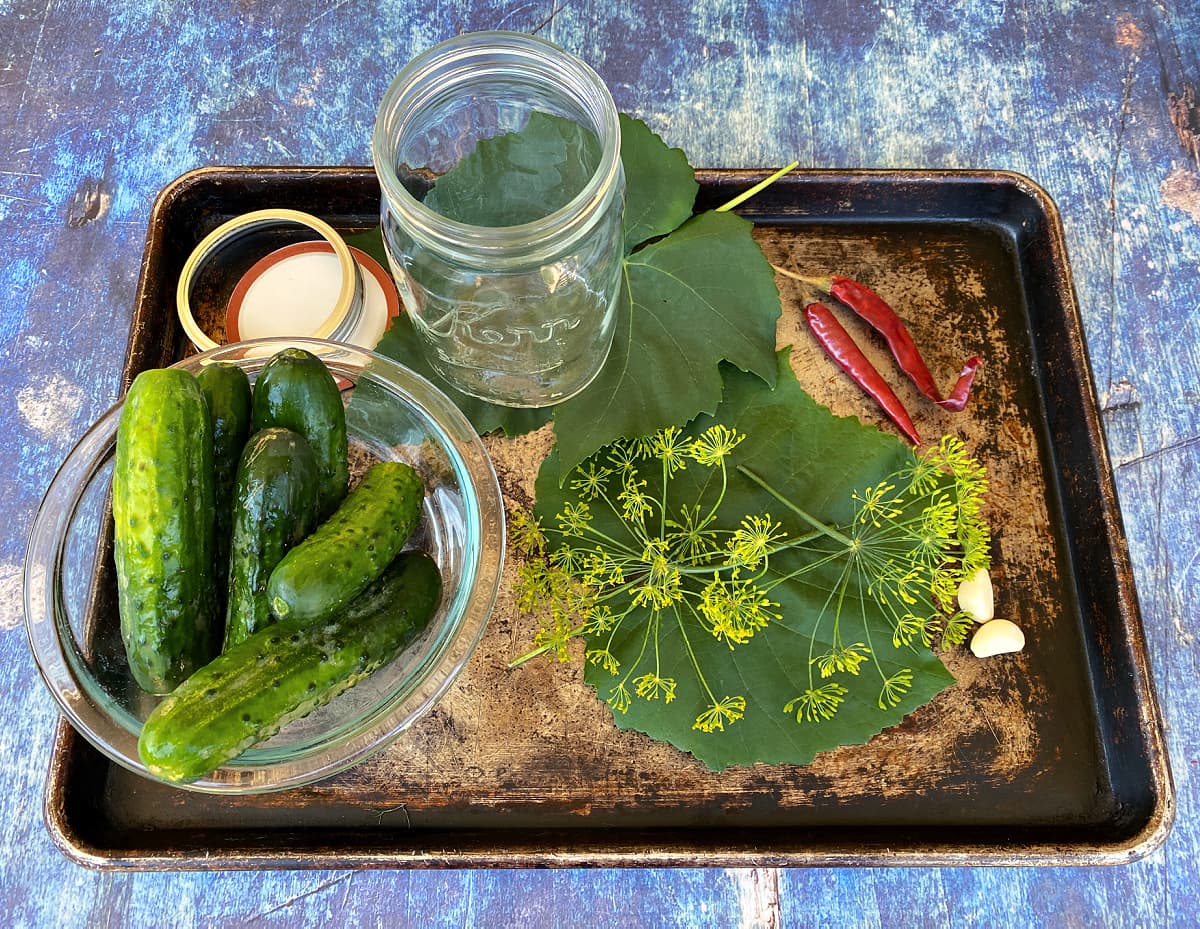
- Cucumbers: Use medium pickling cucumbers, about 4-6 inches(max) in length. Pickling cucumbers are shorter and bigger around than slicing cucumbers. They have thinner skins, a crunchier texture, and smaller seeds, making them perfect for pickling.
- If you don't grow your own pickling cucumbers, visit your local farmers' market or contact your local farm association to find a cucumber farmer in your area.
- Water: In our town, the water is treated with enough chlorine that - without filtering, it can be easily tasted. If you have similar issues, but sure to use filtered water to make the brine.
- Vinegar: Use standard 5% white vinegar (the standard acidity range for most vinegars you buy in the store).
- Pickling salt: Pickling salt, also known as canning salt, is a pure granulated salt (sodium chloride), without any anti-caking agents or additives. Finely textured, it dissolves more quickly that most other salts, and does not cloud.
- Do not use table salt or sea salt in place of pickling salt. If you need a substitute for pickling salt, use the same weight of kosher salt. (Pickling salt and kosher salt measure differently.)
- Fresh dill: Dill can be easily grown, or purchased in season at the farmers' market or at your local grocery store. For dill pickles, you want to use the dill heads. These are the flowering tops on the dill plant. (The delicate, dark green dill fronds are perfect for using is sauces, soups, and drying for later use.)
- The flavor of fresh dill is best just as it begins to flower.
- Check 25 Best Fresh Dill Recipes for more about fresh dill.
- Dried red pepper pods: You need two dried arbol chiles for each quart of dills. These small, bright red dried pepper pods are widely available, and can be purchased at your local mercado, or grocery store in the Mexican food aisle.
- Garlic: For spicy garlic pickles, you need two good-sized garlic cloves for each quart of pickles.
- Peeling the garlic is perhaps the most difficult and tedious part of making dill pickles. The good news is, you can peel them ahead of time and stock them up in the refrigerator. (Or, even better, do what we do and buy them in bulk at Costco!) You can always roast any leftover garlic and use it as needed for cooking, and making compound butters, etc.
- Fresh grape leaves: Conveniently, grape leaves are abundant during the pickle-canning season. Find them at your local vineyard, farmers' market, or even your neighbor's backyard. Do not use jarred grape leaves.
- Grape leaves release tannins which inhibit the enzymes that make pickles soft, helping your pickles to stay crisp. Some picklers believe that removing the blossom end of the cucumbers makes the addition of grape leaves unnecessary, but I'm not about to mess with Pop's pickle recipe.
- You can substitute horseradish leaves for grape leaves.
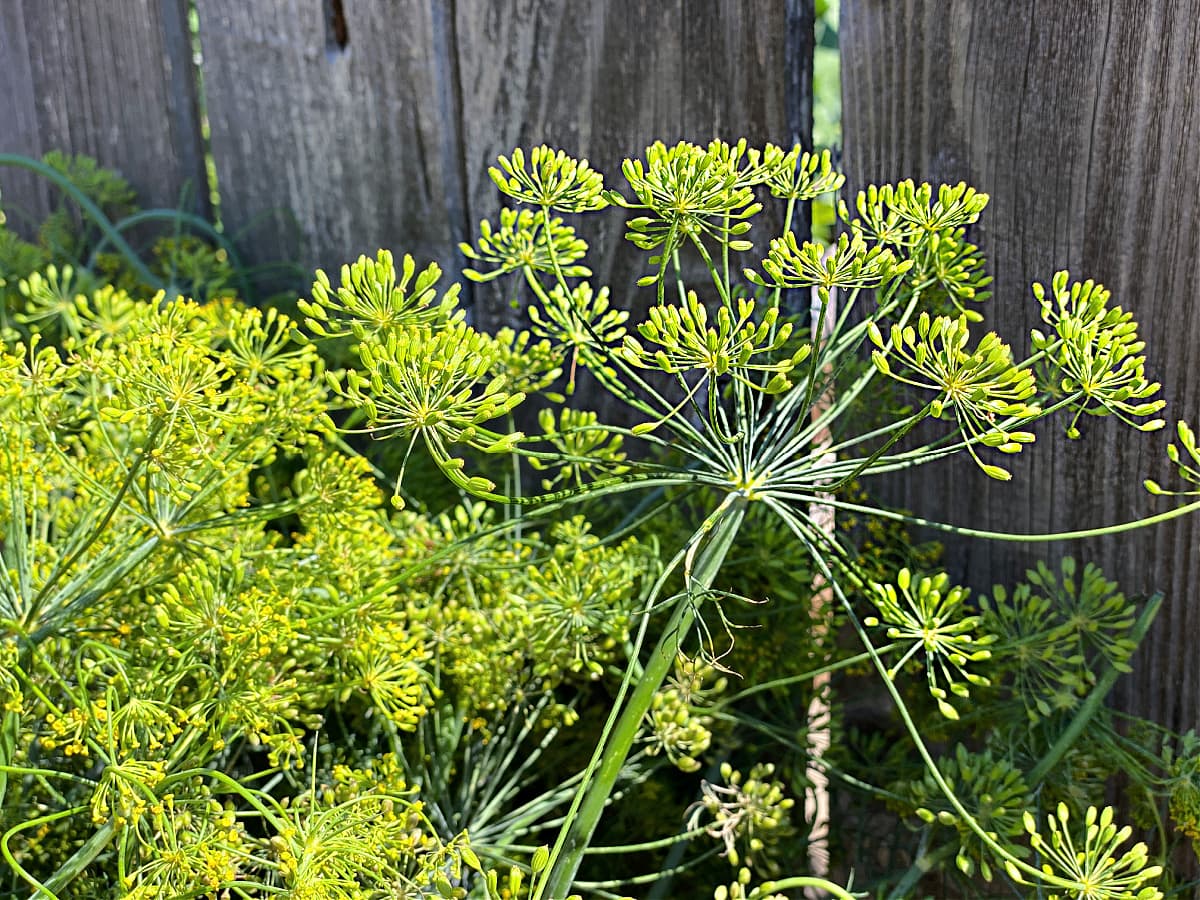
How to Make Spicy Garlic Dill Pickles
This recipe is made in quart-sized canning jars, and processed in a hot water bath.
Cucumber & Jar Prep
Wash cucumbers to remove any dirt and debris and remove the blossom end of each cucumber. (The blossom end contains enzymes that will make your pickles go soft.)
Place cucumbers on ice for at least one hour before making brine. (Doing this helps the cucumbers stay crisper.)
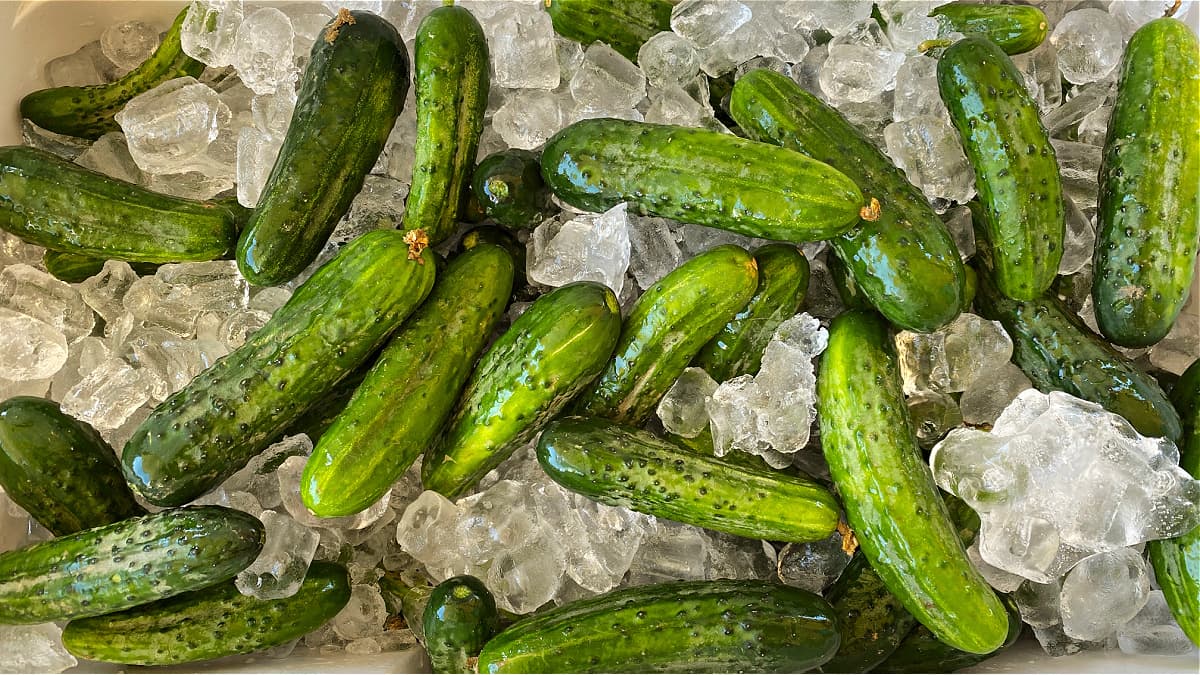
To prepare canning jars, lids, and rings for use, fill a water-bath canner about halfway and set on high heat. Bring the water-bath to a boil while you prepare the pickles for canning.
To make the brine, combine vinegar, water, and salt in large stock pot or saucepan. Heat on HIGH, and bring the brine quickly to a boil. Remove from heat and set aside.
Pack Jars
Drain ice and water from cucumbers and pack the cold cucumbers tightly into quart jars, leaving at least ½-inch headspace. We try to use whole cucumbers as much as possible, but we always have to cut a few cukes to fit the small spaces.
To each jar cucumber-packed jar, add 2 dried red pepper pods and 2 whole cloves of garlic. Slide the stem-end of one large or three small heads of dill into each jar. Maintain ½-inch headspace.
Use only one dried pepper if you prefer your pickles less spicy.
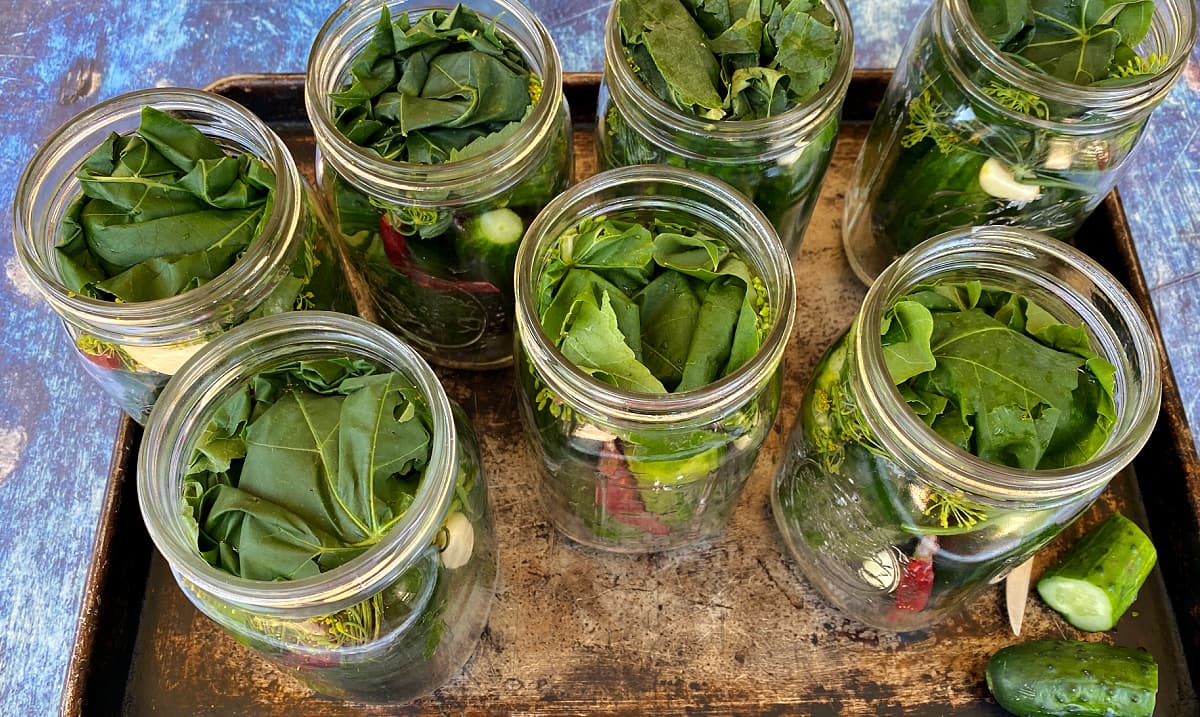
Cover each filled jar with one medium or large grape leaf.
Process Pickles
Reheat brine to a full boil. Ladle brine into the jars, covering the cucumbers and maintaining ½-inch headspace. Use a chopstick or plastic knife to remove any bubbles. If necessary, add more brine to maintain headspace.
Wipe each jar rim with a wet paper towel or clean, wet cloth. Place a lid and ring on each jar and tighten.
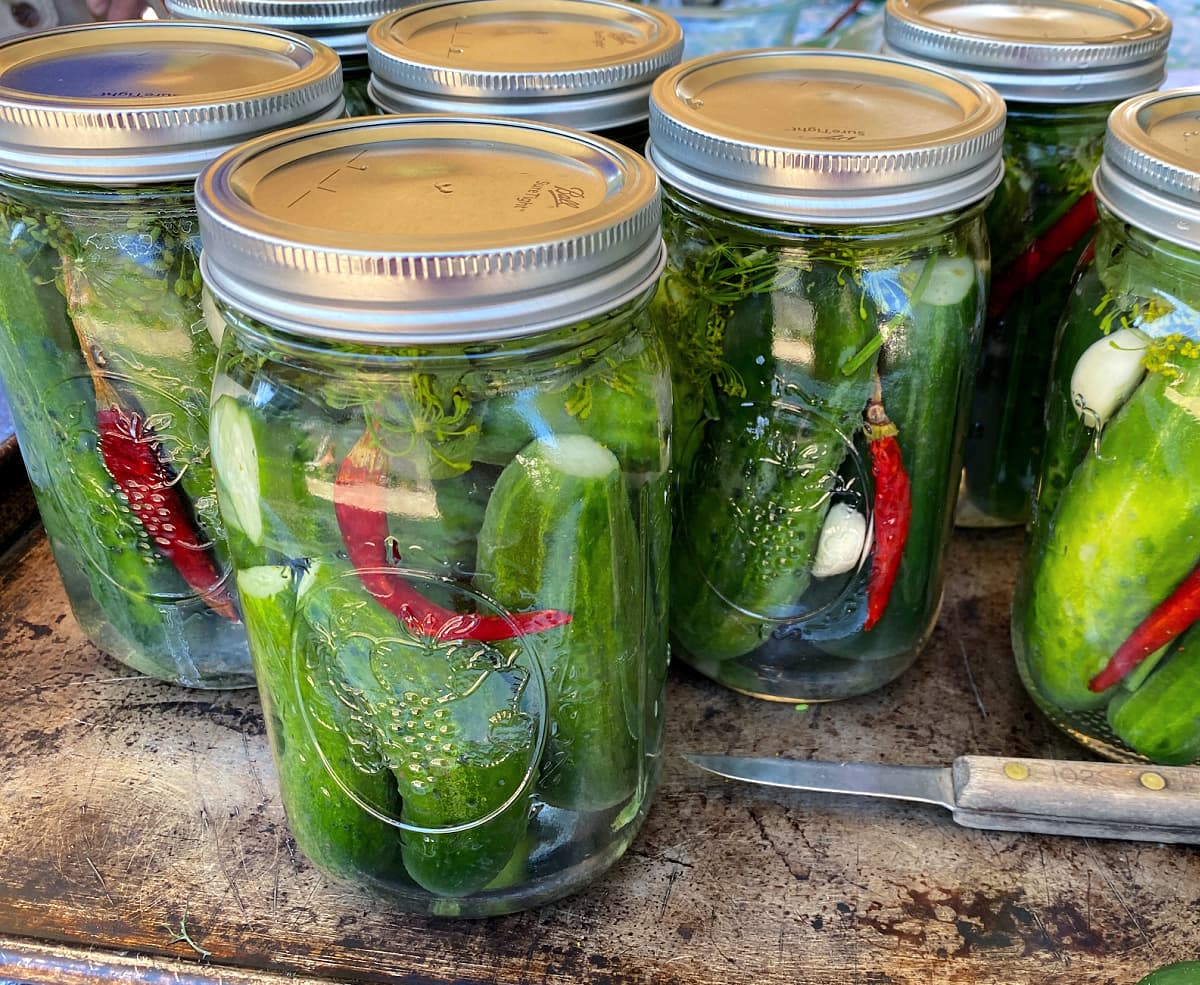
Process both pint and quart jars in a 180° - 185°F [82° - 85°C] water bath for 20 minutes.
Using a jar lifter, carefully place jars in hot water bath.
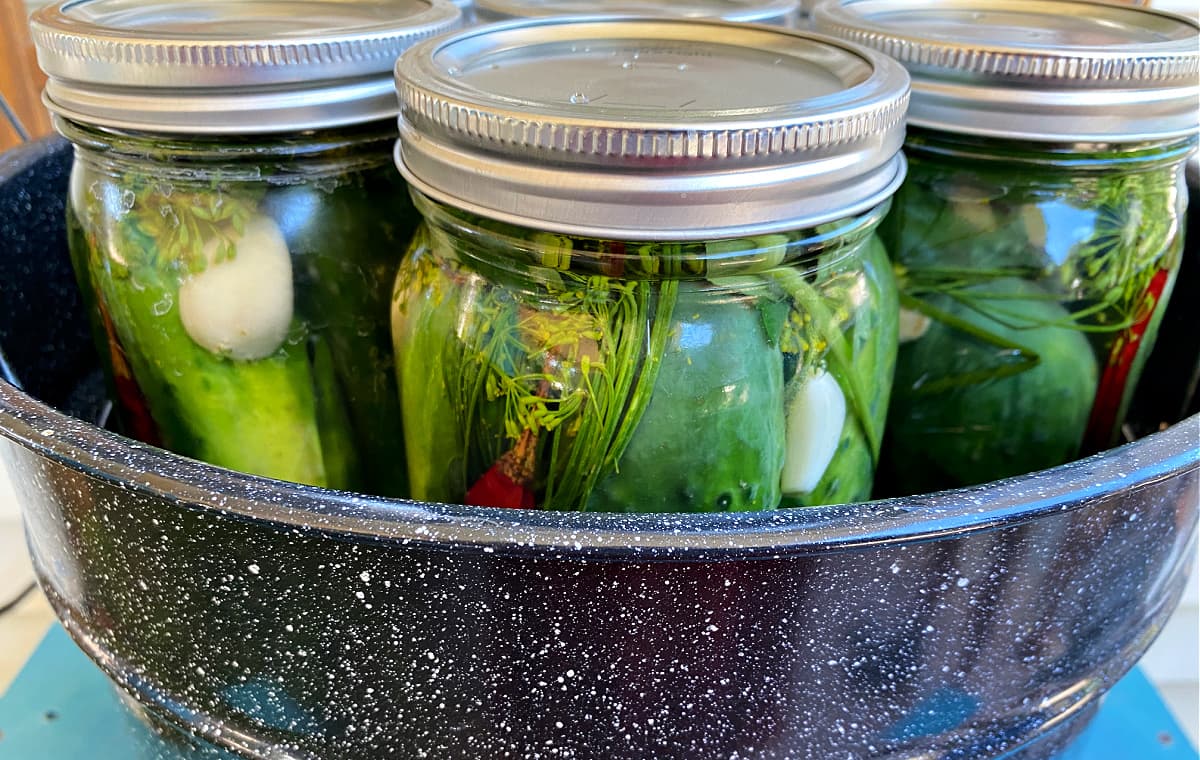
There should be about one inch of water over the tops of the jars. Return canner to HIGH heat, cover, and bring to a simmer, processing for 20 minutes. (Start time only when water reaches a simmer again; 180° - 185°F (82° - 85°C).)
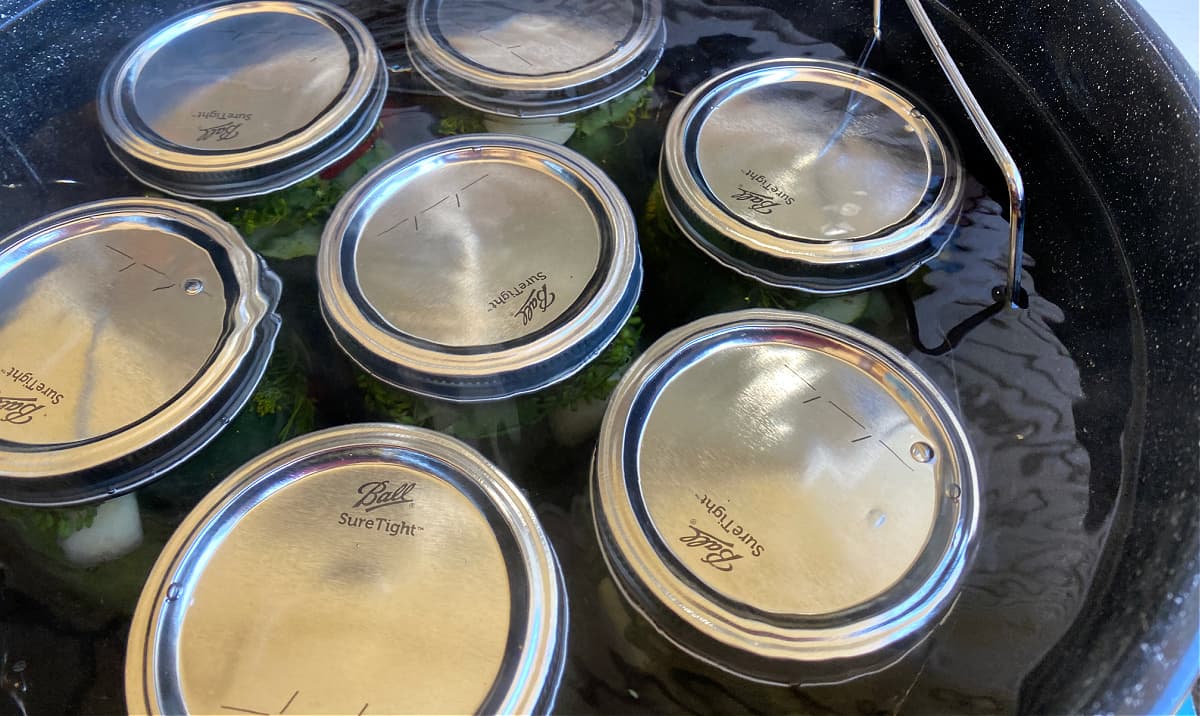
After processing, wait 5 minutes before removing the jars from the canner. Place hot pickles jars on a cloth on the counter. Allow them to rest until completely cooled before storing.
Write the canning date on the jar lids once they have completely cooled. (It's amazing have easy it is to forget what year pickles were canned)
Garlic Dills are ready to eat in six or eight weeks. (Be patient!)
Variations
- Mild Garlic Dills: Omit the hot peppers.
- Super-Garlicky Dills: Double the garlic.
Equipment
Mason Jars
To make this spicy pickle recipe, you will need 4 wide mouth quart-size canning jars with lids and bands for each batch.
Make sure you use only Mason-type jars. We do not recommend using mayonnaise or other repurposed jars. According the National Center for Home Food Preservation, a Mason-type jar specifically designed for home canning is the best option. Most commercial pint- and quart-size mayonnaise jars have a narrower sealing surface and are tempered less than Mason jars, and even minute scratches in the glass may cause cracking and breakage while processing jars in a canner.
Water Bath Canner
You will also need a water bath canner with a rack on the bottom. We prefer a graniteware canner: its porcelain-covered steel surface provides excellent heat distribution, reducing heat up time and saving energy.
Warning: If you have a glass cooktop, check your stove manufacturer guidelines about canning on smooth cooktops before canning anything. Generally, canning on a glass cooktop using a water bath or pressure canner is not recommended because the weight of a canner filled with jars and water may crack a glass cooktop. Some manufacturers advise limits on the diameter of the canner compared to the diameter of the burner and on the total weight of the canner.
Storage
Pickles should be stored in a cool, dark place. For best flavor and texture, dill pickles should be eaten within a year of the date they were made, and within 3 to 4 months of opening the jar. Pickles should be refrigerated once the seal is broken.
FAQ
Unlike "table salt," pickling salt does not contain anti-caking ingredients or additives like iodine. And because it lacks these anti-caking properties, pickling salt can turn into a solid brick, especially in humid or rainy conditions. Table salt, on the other hand, has additives that keep it from caking, so it will stay granular and pour smoothly... thus, "When it rains, it pours."
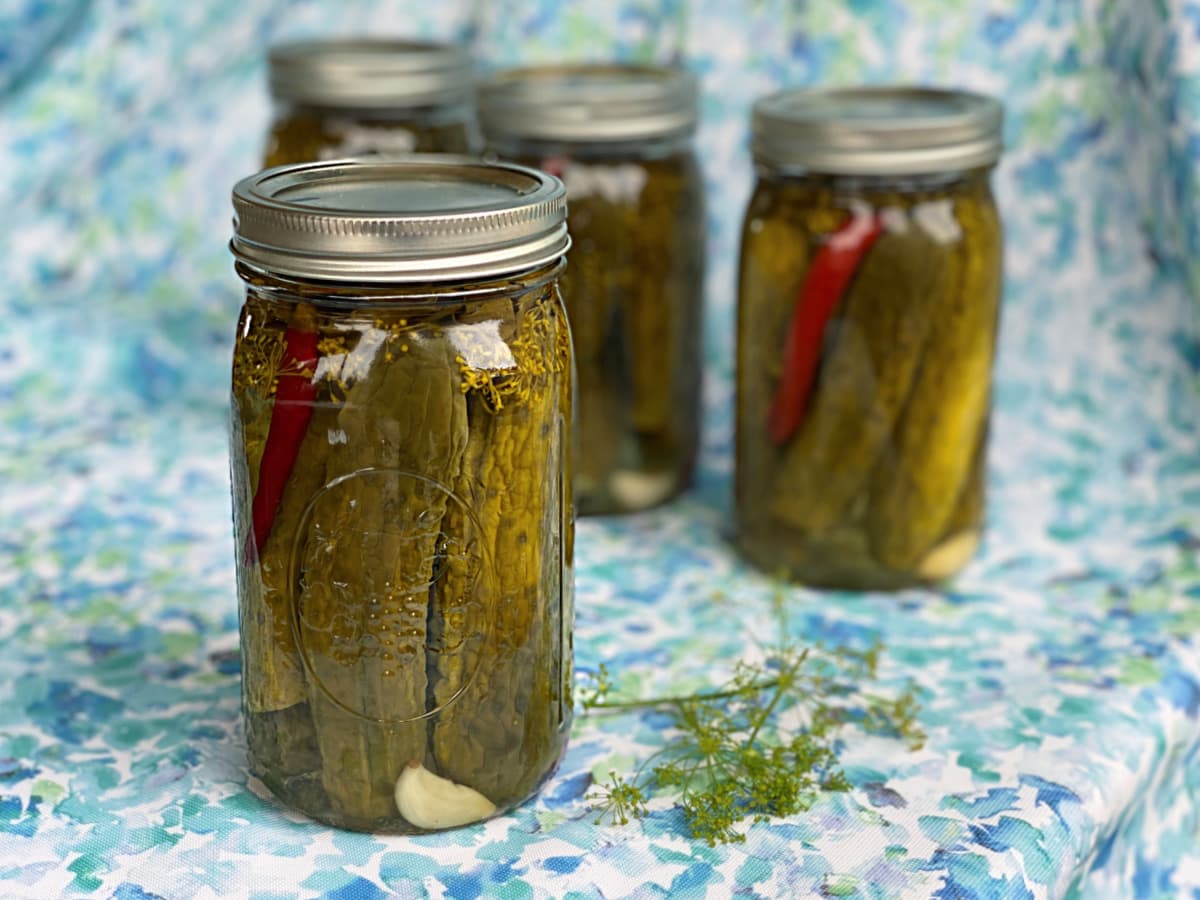
For Pickle Lovers Only
If you love sweet and sour together, try our Old-fashioned Bread & Butter Pickles! These crisp, tangy pickles are perfect for burgers, sandwiches, picnics, or simply snacking.
No Waiting! If you are in the mood for a pickle today, try our Swedish Cucumbers (Easy Quick Pickle)!
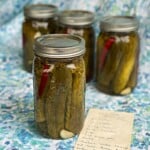
Pop's Spicy Garlic Dill Pickles
Equipment
- 1 Water bath canner
- Quart-size canning jars
Ingredients
- 7-8 pounds medium pickling cucumbers
- 1 quart water
- 1 pint white vinegar
- ½ cup pickling salt
- 8 heads dill
- 8 small dried red pepper pods
- 8 cloves garlic
- 4 large fresh grape leaves
Instructions
Prepare Cucumbers
- Wash cucumbers to remove any dirt and debris and remove the vine end of each cucumber.
- OPTIONAL: Place cucumbers in ice bath for one hour before making brine. Doing this helps the cucumbers stay crisper.
Prep Jars & Lids
- Prepare canning jars, lids, and rings for use.Fill a water-bath canner about half full and set on high heat. Bring the water-bath to a boil while you prepare the pickles for canning.
Make Brine
- To make the brine, combine vinegar, water, and salt in large stock pot or saucepan. Heat on HIGH, and bring the brine quickly to a boil. Remove from heat and set aside.
Pack Jars
- Drain ice and water from cucumbers and pack the cold cucumbers tightly into quart jars, leaving at least ½-inch headspace. We try to use whole cucumbers as much as possible, but we always have to cut a few cukes to fit the small spaces.
- To each jar cucumber-packed jar, add 2 dried red pepper pods and 2 whole cloves of garlic. Slide the stem-end of one large or three small heads of dill into each jar. Maintain ½-inch headspace. Use only one dried pepper if you prefer your pickles less spicy.
- Cover each filled jar with one medium or large grape leaf.
Process Pickles
- Process both pint and quart jars in a 180° - 185°F [82° - 85°C] water bath for 20 minutes.
- Reheat brine to a full boil. Ladle brine into the jars, covering the cucumbers and maintaining ½-inch headspace. Use a chopstick or plastic knife to remove any bubbles. If necessary, add more brine to maintain headspace. Wipe each jar rim with a wet paper towel or clean, wet cloth. Place a lid and ring on each jar and tighten.
- Using a jar lifter, carefully place jars in hot water bath. There should be about one inch of water over the tops of the jars.
- There should be about one inch of water over the tops of the jars. Return canner to HIGH heat, cover, and bring to a simmer, processing for 20 minutes. Start time only when water reaches a simmer again; 180° - 185°F [82° - 85°C].
- After processing, wait 5 minutes before removing the jars from the canner.
- Place hot pickles jars on a cloth on the counter. Allow them to rest until completely cooled before storing.
Have Patience
- Ready to eat in 6 or 8 weeks.
Notes
Nutrition
This website provides approximate nutrition information for convenience and as a courtesy only. You are solely responsible for ensuring that any nutritional information provided is accurate, complete, and useful.

Want More Free Recipes?
Subscribe to our newsletter to get family-friendly recipes and cozy living ideas in your inbox each week!
Find us on Instagram, Pinterest, and Facebook, too.
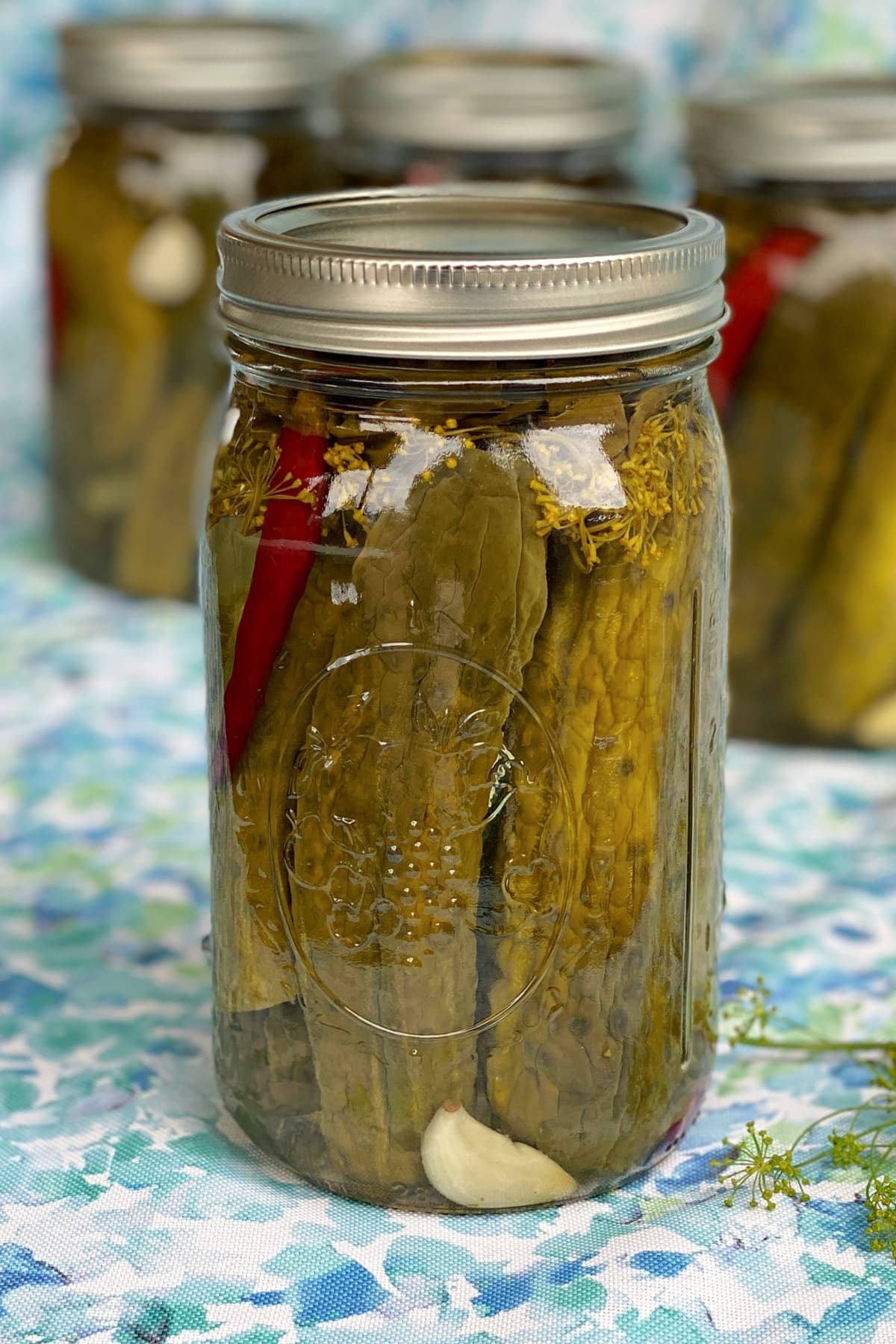
Thank you for visiting the Good Hearted Woman. Remember to bookmark this site, and come back soon!



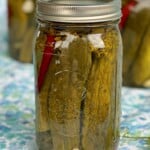
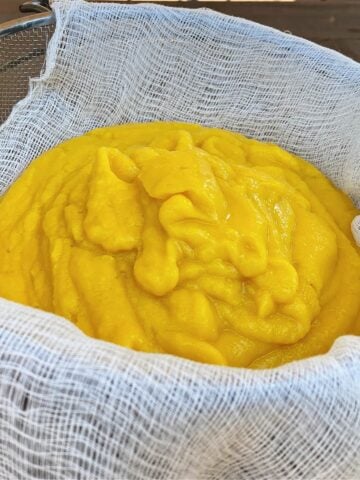
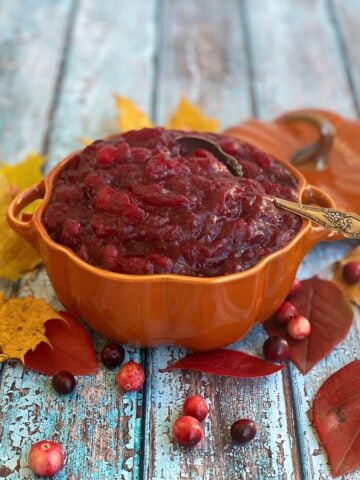
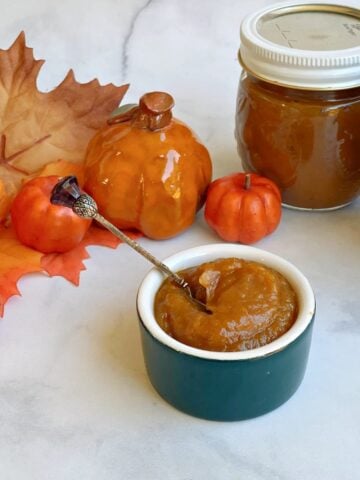
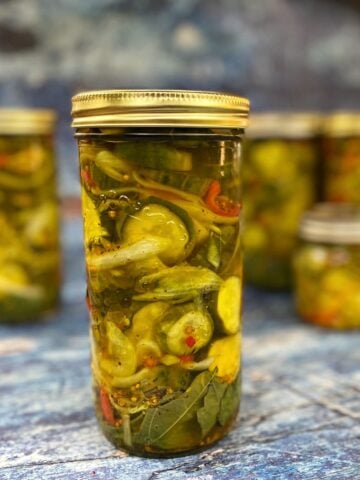
Ariel says
A friend of mine makes these and I love the recipe. Is there a way to make dill pickle relish using this recipe as a starting point? Or could I slice them instead of putting them in whole?
Renée B. says
I've never made dill pickle relish from this particular recipe. Relishes typically have additional flavoring agents and thickeners in them, so I'd need to do a little more research before I gave it a try.
Bob says
Tried this recipe but added a lot more peppers, everything from my garden but the Vinegar and salt. came out perfect. Family loves them, only made 4 jars this time, can't wait for next year's crop
Renée B. says
It is so satisfying to take something from garden to table, isn't it?! I'm so glad everyone loves them!
Elisa says
Love this Pop's Spicy Garlic Dill Pickles recipe!! will make it for my daughter that loves pickles. They look delicious. Thanks for sharing 🙂
Ieva says
Great recipe! My pickles are done and I can hardly wait for 6 weeks to taste them. The recipe was easy to follow and you've put in so much valuable information in this post! So interesting to know about the enzymes in the blossom and the difference in salts.
Renée B. says
The science of pickling, and canning in general, is so interesting.
Sara Welch says
Pickles are my go-to snack and this recipe was no exception! Easy, delicious and budget friendly! Love it!
Renée B. says
Dill pickles are a totally guilt-free snack!
Elena says
I love this recipe and the story behind it. It is similar to how my grandma would make pickles, with lots of dill. It is a bit time-consuming but the effort is so worth it. Thank you for sharing it!!
Renée B. says
They are definitely worth the time! Thanks for taking the time to read the story - those memories mean a lot to me.
Beth says
These spicy garlic dill pickles are a flavor explosion in every bite! Perfect Summer snack!
Cathy Enderby says
The hand written recipe I have calls for 1 tsp of sugar to each quart jar. Is this necessary? I hope I can find grape leave, because I want to try your recipe.
Renée says
No sugar is used in this recipe.
Ask around; you may have a friend with a grape vine who would let you have some leaves.
Nancy Clifton says
I am so happy I found this recipe! It is just like my mom's. I hvw my mom's but her handwritibg is impossible. So excited to have this. My mom pased on in 1994 so it has been a long time.
Renée says
I'm so glad you found what you were looking for! (My mom's handwriting was indecipherable at times, too. I get it.)
Travis Williams says
This is a really salty recipe, I would cut back to 1/4 cup. A few of my friends have all tried it and found it too salty for our tastes.
Renée B. says
This is a fermented pickle recipe. The pickling salt not only provides flavor; it helps to promote the growth of desirable bacteria, and inhibits the growth of other undesirable bacteria. So, while you can certainly reduce the salt for your own use, we cannot recommend reducing the salt in this case.
(Just a reminder; always use pickling salt for this recipe.)